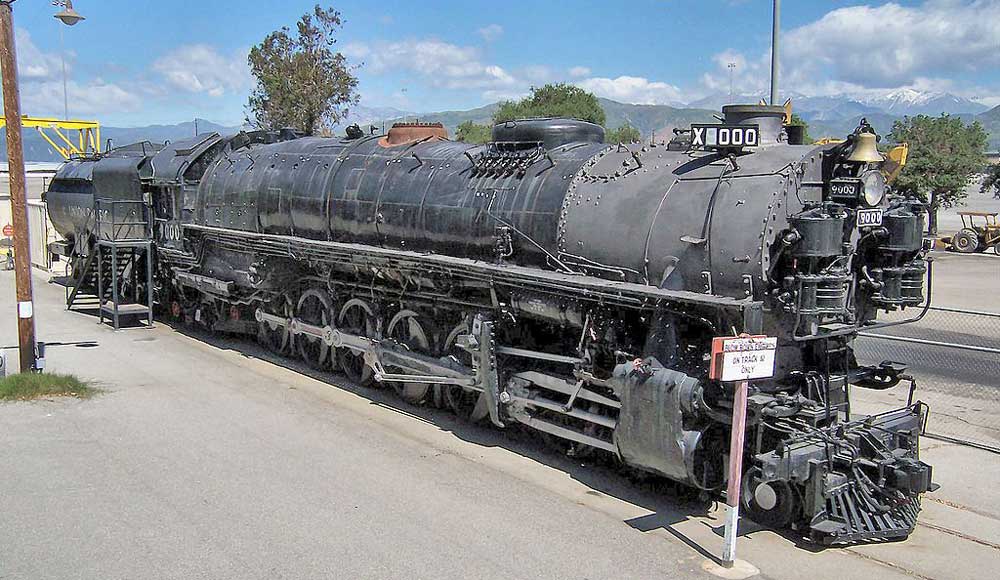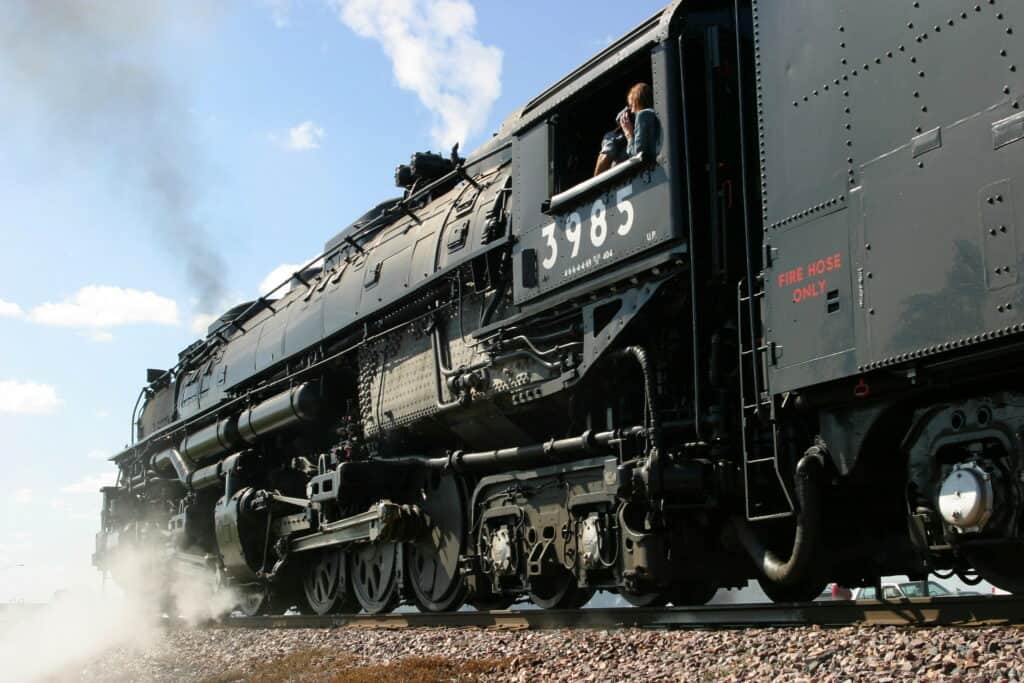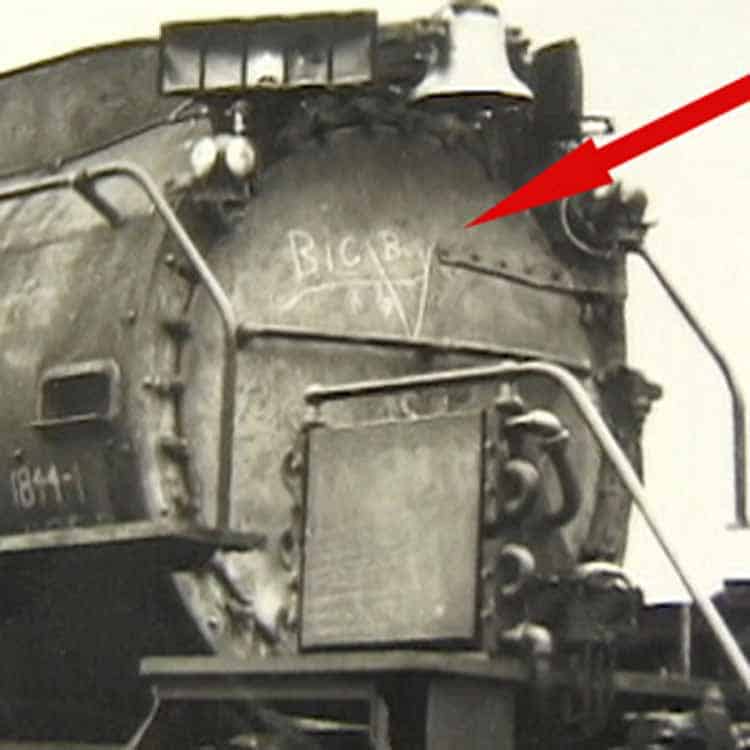Why the need for Big Boy’s Power?
The Union Pacific locomotives nicknamed “Big Boy” were true steam giants at 132 feet long (with tender) and 16 feet tall – weighing in at over a million and a quarter pounds. All of that steel and coal means a lot of power. Why did Union Pacific need all the muscle?
Another nickname for the massive 4-8-8-4 Big Boy will give us a clue why Union Pacific needed the power. The Big Boy was also called “Titan of the Wasatch”. The locomotive was designed to conquer the Wasatch Mountains. These massive locomotives were designed and built for one reason: they were purpose-built to pull long, heavy freight trains, unassisted, over one specific route.
The Union Pacific’s run over the Wasatch Mountains, heading west, begins at Green River, Wyoming at 6,100 feet above sea level. The line then rises quickly to 7,300 feet at Aspen Tunnel near the Wyoming, Utah line. From there, through a series of twists, turns, gorges and tunnels the double track mainline drops just as quickly to 4,300 feet above sea level at Ogden, Utah. The ruling grade eastbound, upgrade, is a stiff 1.14% while the westbound, downgrade, slope hits 1.77%.
This 176 mile section of track was no backwater line, no branch line, not even a secondary main. This was the double tracked “Overland Route”, the line that first connected the continent, east to west, in 1869. This was the Union Pacific’s only line between the industrial heartland and connections with the east, and the industrial powerhouse cities of the west.
Union Pacific had a history of bigger and bigger power
This, and Sherman Hill, at 8,000 feet above sea level, had been the Union Pacific’s geography problem for 70 years. And they solved it with more and bigger power. The Big Boy was just the natural result of this need for power. It was just the latest in a line of behemoths.
One of the first attempts by Union Pacific to conquer the geography problem with a purpose-built locomotive was the 9000 class built in the late 1920’s. This 4-12-2 locomotive could muster 4,750 horsepower, a tractive effort of 97,664 pounds on the rails. (Learn more about the “9000 Class”.)
The 9000 class had some maintenance issues, mainly because of the placement of a third inside-the-frame cylinder. The UP was the only US railroad to roster any 4-12-2 locomotives, so this became known as a Union Pacific type. Of the 88 built there is one preserved, at the RailGiants Museum in Pomona, California.
The Union Pacific learned from the 9000 series and in 1935 designed the Challenger, a 4-6-6-4 simple articulated locomotive. While the 9000 had been a rigid frame locomotive, the UP knew that making a bigger, longer wheelbase locomotive would mean designing an articulated locomotive. An articulated locomotive essentially breaks the driving wheels into “engine units”, under one boiler. It allows a larger boiler, so more power, but still maintains the ability to go around standard curves.

The 4-6-6-4 Challenger. Almost there.
The Challenger class (read more about these locomotives in our article “The Challengers”) took to the rails with 5,000 horsepower and a tractive effort of 97,350 pounds. Not much more than the 9000 class and yet the articulation and heavier weight (weighing 150 tons more) allowed the Challengers to pull more, faster.
The Challenger was an immediate success, and Union Pacific had 105 on the property by the end of steam. While this 4-6-6-4 was a success, it still had trouble in the one area for which it was most needed – the section of 1.14% grade in the Wasatch Mountains. Hauling a long, heavy train – the goal of the Union Pacific – still required adding helpers at the base of the Echo Canyon climb.
And so, more power was needed. It was back to the drawing board. And you know the rest of the story…but we’ll tell it in brief here for those who don’t. The managers and civil engineers at Union Pacific who designed the Challenger knew the 4-6-6-4 had almost done the job. It had done everything they asked of it, except that short 65 mile section of track that climbed a 1.14% grade. So, if they had come that close with this design, it was obvious – they just needed to think bigger!

Size does Matter
That’s when Big Boy appeared on the drafting boards in Union Pacific’s Research and Mechanical Standards Department. It wasn’t quite as easy as super-sizing a 4-6-6-4 Challenger, but it wasn’t like starting over from scratch either and so it only took three months to come up with plans for the 4000 class, a 4-8-8-4 locomotive.
Those plans went to long-time UP favorite UP builder American Locomotive Company (ALCo) in Schenectady, New York. In about a year ALCo delivered the first Big Boy, #4000, on September 4th, 1941. UP wasted no time in testing out the new behemoth. #4000’s first trip to Ogden, over the Wasatch Range, came on September 9th. This time, Union Pacific got it right. The Big Boy truly was the “Titan of the Wasatch” as it powered through every criteria management had set. And powered up the Wasatch Grade!
By the numbers, this new 4000 series, the Big Boy, rivaled all other steam locomotives: Another 150 tons at 604 tons (A million and a quarter pounds when fueled up), 6,300 horsepower and a tractive effort of 135,275 pounds on the rails. Just a quick comparison of these few numbers show Union Pacific wasn’t following around this time!

Success with the Big Boy
For the next 20 years, and millions of miles, 25 of these beasts would work that grade, as designed, without helpers, pulling massive amounts of freight. The Big Boys and their crews would be important assets to the Union Pacific, and during World War II were important assets to the war effort as the Union Pacific moved massive amounts of munitions and tanks and aircraft east and west from factories to ports as they were needed in the various theaters of war.
The Union Pacific truly needed the power and the Big Boy delivered. Interesting, and of course, the end of steam did not mean the end of UP’s geographic obstacles and so the railroad continued to design bigger and more powerful engines, but now they would be diesels, or other exciting technologies!

Railfan and model railroader. Writer and consumer of railroad news and information.





